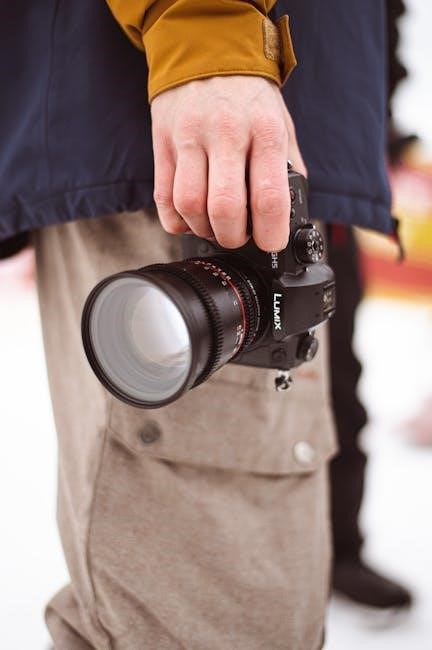This manual provides a comprehensive guide to the Nikon D80 camera‚ covering its features‚ shooting modes‚ menu navigation‚ and safety tips for optimal photography experiences.
1.1 Purpose and Scope of the Manual
This manual is designed to help users understand and utilize the Nikon D80 camera’s features effectively. It covers essential functions‚ shooting modes‚ and troubleshooting tips‚ ensuring photographers of all levels can optimize their experience. The guide includes safety precautions‚ menu navigation‚ and customization options‚ providing a comprehensive resource for mastering the camera’s capabilities and enhancing photographic outcomes through practice and exploration of its advanced settings.
1.2 Safety Precautions and Handling Tips
Always follow safety guidelines to prevent damage or injury. Avoid looking directly at the sun through the viewfinder‚ as it may cause eye damage. Handle the camera and lenses with care to prevent scratches or breakage. Store the device in a cool‚ dry place‚ away from extreme temperatures and humidity. Use only genuine Nikon accessories to ensure compatibility and performance. Read all warnings carefully before use to avoid malfunctions and ensure safe‚ reliable operation of your Nikon D80 camera.
Key Features and Technical Specifications
The Nikon D80 DSLR features a 10.2-megapixel CMOS sensor‚ 2.5-inch LCD‚ and compatibility with Nikon lenses and flash systems‚ offering RAW and JPEG shooting options.
2.1 Overview of the Nikon D80 Camera
The Nikon D80 is a 10.2-megapixel DSLR featuring a CMOS sensor‚ 2.5-inch LCD screen‚ and compatibility with Nikon F-mount lenses. It offers advanced shooting modes‚ RAW and JPEG formats‚ and integrates with the Nikon Creative Lighting System for enhanced flash control. Designed as a successor to the D70/D70s‚ the D80 combines user-friendly design with professional-grade features‚ making it versatile for both enthusiasts and professionals.
2.2 Technical Specifications and Hardware Details
The Nikon D80 features a 10.2-megapixel APS-C CMOS sensor‚ measuring 23.6 x 15.8mm‚ with a sensitivity range of ISO 100-1600 (expandable to 3200). It utilizes the EXPEED processing engine and offers 11 autofocus points. The camera includes a 2.5-inch‚ 230k-dot LCD monitor and supports SD and SDHC memory cards. The D80 is compatible with Nikon’s Creative Lighting System and operates on EN-EL3e batteries‚ providing up to 2‚700 shots per charge. Its dimensions are 132 x 105 x 76mm‚ weighing approximately 585 grams.
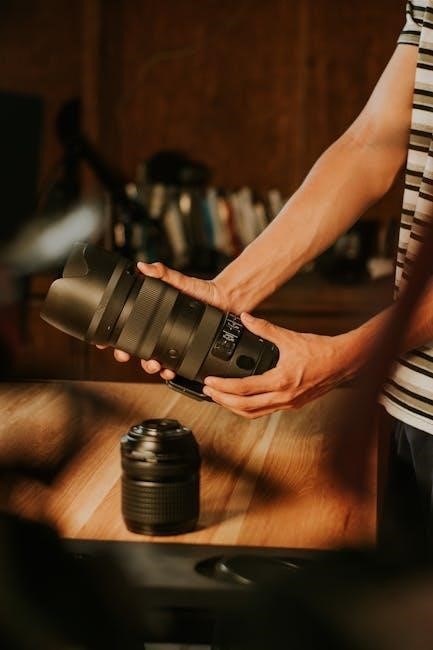
Camera Controls and Menu Navigation
The Nikon D80 features intuitive external controls and a user-friendly menu system‚ allowing easy access to shooting modes‚ autofocus settings‚ and custom functions for efficient camera operation.
3.1 Understanding the Camera’s External Controls
The Nikon D80’s external controls are designed for quick access to key functions. The mode dial allows selection of shooting modes‚ while the multi-selector navigates menus and selects AF areas. Dedicated buttons for ISO‚ white balance‚ and flash modes streamline adjustments. The AF and metering mode buttons enable fast changes‚ ensuring intuitive operation. These controls provide a seamless interface for photographers to customize settings and capture images efficiently. Proper use enhances creativity and workflow‚ making the D80 user-friendly for both beginners and professionals.
3.2 Navigating the Menu System
Navigating the Nikon D80’s menu system is straightforward‚ using the multi-selector to scroll through options. The menu is divided into sections like shooting‚ custom‚ and playback settings. Key functions include adjusting image quality‚ ISO‚ and AF modes. The interface is user-friendly‚ allowing quick access to settings without complexity. Familiarity with the menu enhances control over the camera’s features‚ ensuring optimal performance in various shooting scenarios. Proper navigation enables photographers to tailor settings to their creative vision efficiently.
3.4 Customizing Menu Options
The Nikon D80 allows users to customize menu options for personalized shooting experiences. The “My Menu” feature enables quick access to frequently used settings‚ streamlining workflow. Users can select and arrange up to 20 menu items‚ making navigation more efficient. Additionally‚ custom settings banks store camera configurations‚ simplifying setup for different shooting conditions. This customization capability enhances productivity and ensures that the camera adapts to individual preferences‚ making it versatile for various photographic needs and styles.
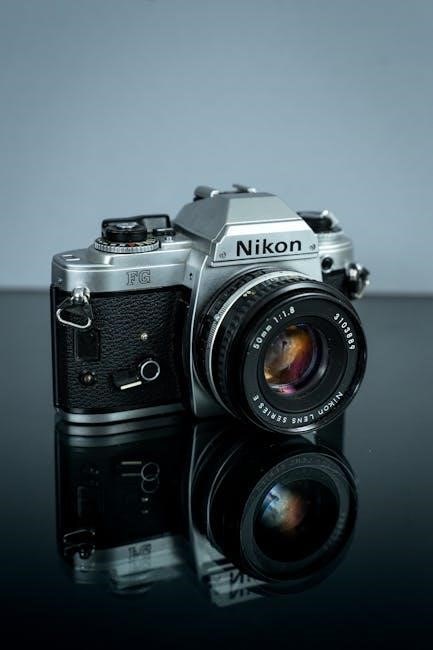
Shooting Modes and Options
The Nikon D80 offers versatile shooting modes‚ including Auto‚ Program‚ Aperture Priority‚ Shutter Priority‚ and Manual‚ catering to both beginners and advanced photographers for precise control and flexibility.
4.1 Auto Mode for Beginners
The Auto Mode on the Nikon D80 is designed for beginners‚ offering a straightforward‚ point-and-shoot experience. It automatically adjusts exposure‚ autofocus‚ ISO‚ and white balance‚ making it ideal for those new to photography. This mode simplifies camera operation‚ allowing users to focus on composition and creativity without manual adjustments. While it limits control‚ it ensures sharp‚ well-exposed images‚ making it perfect for learning the basics before exploring advanced settings;
4.2 Program Mode for Versatility
Program Mode offers versatility by automatically setting aperture and shutter speed while allowing user adjustments to ISO‚ white balance‚ and flash. It provides a balance between ease and control‚ making it suitable for various shooting conditions. This mode is ideal for photographers who want flexibility without manual operation‚ ensuring optimal results in different lighting scenarios while maintaining creative freedom.
4.3 Aperture Priority Mode
Aperture Priority Mode allows you to set the aperture while the camera automatically adjusts the shutter speed. This mode is ideal for controlling depth of field‚ enabling creative decisions about blur and focus. It is particularly useful for portrait and landscape photography‚ where depth of field is critical. By adjusting the aperture‚ you can achieve the desired blur effect‚ while the camera ensures proper exposure by selecting an appropriate shutter speed.
4.4 Shutter Priority Mode
Shutter Priority Mode lets you set the shutter speed‚ with the camera adjusting the aperture automatically. This mode is perfect for capturing motion‚ such as freezing fast-moving subjects or creating motion blur. It offers control over the dynamic feel of your photos‚ making it ideal for sports‚ action‚ and low-light photography. By selecting the shutter speed‚ you can achieve the desired effect‚ while the camera ensures proper exposure by adjusting the aperture accordingly.
4.5 Manual Mode for Full Control
Manual Mode offers complete control over both aperture and shutter speed‚ allowing photographers to fine-tune their settings for precise results. This mode is ideal for experienced users who want to experiment with creative techniques. By adjusting aperture and shutter speed independently‚ you can achieve unique effects like shallow depth of field or intentional motion blur. The Nikon D80’s Manual Mode empowers users to push their creative boundaries and capture images exactly as envisioned‚ making it a powerful tool for artistic expression and technical control.
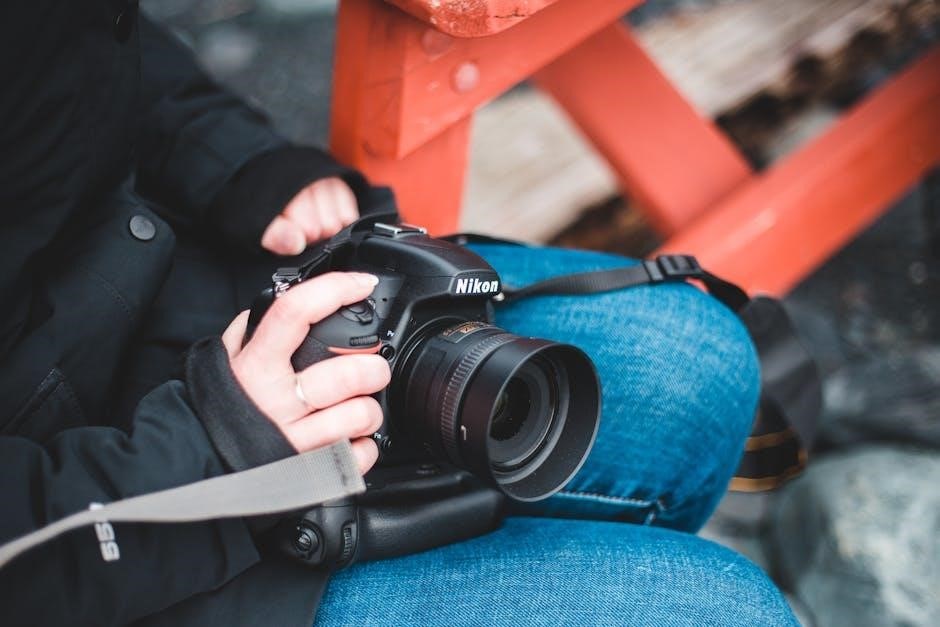
Exposure and Metering
Exposure and metering are crucial for capturing images with the desired brightness and contrast. The Nikon D80 offers advanced tools to achieve precise control over lighting and shadows.
5.1 Understanding Exposure Compensation
Exposure compensation allows adjustments to brightness in +/-5 EV increments‚ enhancing or reducing image brightness. Use the +/- button with the command dial for precise control. This feature is ideal for correcting backlit or high-contrast scenes‚ ensuring balanced exposure. The D80’s metering system supports this function‚ offering flexibility in various lighting conditions. Proper use of exposure compensation enhances image quality‚ making it a valuable tool for photographers seeking optimal results.
5.2 Metering Modes Explained
The Nikon D80 offers three metering modes: Matrix‚ Center-Weighted‚ and Spot. Matrix metering analyzes the entire scene for balanced exposure. Center-Weighted prioritizes the central area‚ ideal for classic compositions; Spot metering measures light from a specific point‚ useful for high-contrast scenes. Each mode provides precise control over exposure‚ ensuring optimal results in various lighting conditions. Understanding these modes enhances your ability to capture images with accurate brightness and detail‚ making them essential tools for photographers. Proper use of metering modes is crucial for achieving professional-quality photos.
Autofocus and AF Modes
The Nikon D80 features advanced autofocus system with modes like Single AF‚ Continuous AF‚ and Manual Focus. These modes offer flexibility for precise subject tracking and control.
6.1 Autofocus Basics
The Nikon D80’s autofocus system ensures sharp images by quickly locking onto subjects. It uses advanced sensors to detect focus areas‚ allowing for precise and fast subject acquisition. Users can select different AF modes to suit their photography needs. Proper lens alignment and settings are essential for optimal performance. Regular calibration and maintenance can enhance autofocus accuracy and reliability. Understanding these basics helps photographers achieve professional-quality results with ease and consistency in various shooting conditions.
6.2 AF Modes and Customization
The Nikon D80 offers various AF modes‚ including Single AF and Continuous AF‚ to adapt to different photography scenarios. Single AF is ideal for stationary subjects‚ while Continuous AF tracks moving subjects. The camera also features Dynamic AF Area modes‚ which allow for more precise subject tracking. Customization options enable users to tailor AF settings to their preferences‚ such as adjusting AF-C mode settings or fine-tuning focus tracking. These features ensure versatility and improved autofocus performance in diverse shooting conditions.

White Balance and ISO Settings
White balance ensures accurate color reproduction under various lighting conditions‚ with options like Auto‚ Daylight‚ and Cloudy. ISO settings optimize sensitivity for low-light shooting‚ minimizing noise effectively.
7.1 White Balance Explained
White balance adjusts color tones to match lighting conditions‚ ensuring natural hues. Options include Auto‚ Daylight‚ Shade‚ Cloudy‚ Fluorescent‚ and Incandescent. Custom settings allow precise calibration for specific environments‚ enhancing image accuracy and reducing unwanted color casts in various lighting scenarios for optimal photography results.
7.2 ISO Settings and Noise Reduction
ISO settings on the Nikon D80 range from 100 to 1600‚ allowing low-light photography. Higher ISOs can introduce noise‚ but built-in noise reduction minimizes grain‚ preserving image clarity. Customizable noise reduction levels ensure optimal balance between detail and smoothness‚ enhancing overall photo quality in various lighting conditions for professional-grade results.
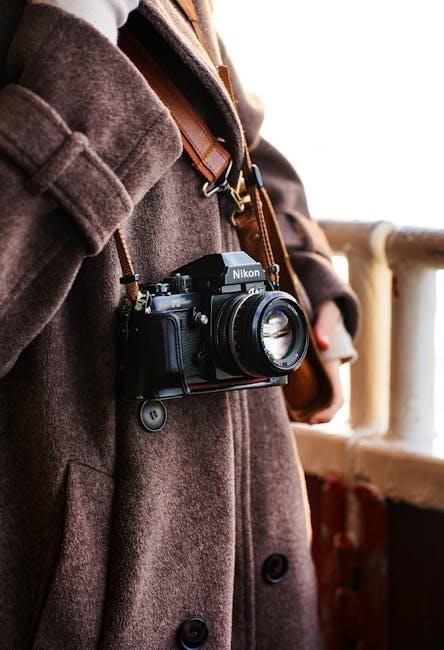
Flash and Lighting
The Nikon D80 supports built-in flash and external Speedlights‚ integrating with the Nikon Creative Lighting System for advanced i-TTL control. This ensures precise‚ professional lighting results effortlessly.
8.1 Using the Built-in Flash
The Nikon D80’s built-in flash offers convenient lighting for various scenarios. It supports i-TTL flash control‚ enabling automatic and precise exposure. The flash can be activated via the camera’s controls‚ providing optimal illumination for low-light conditions. Additionally‚ it can function as a commander for wireless flash setups‚ enhancing creative lighting options. Proper use ensures balanced lighting and professional results‚ making it an invaluable tool for photographers of all skill levels.
8.2 Compatible External Speedlights
The Nikon D80 supports various external Speedlights‚ including the SB-800‚ SB-600‚ and SB-R200‚ through the Nikon Creative Lighting System. These Speedlights enhance flexibility and control‚ offering advanced i-TTL flash capabilities. They can be used in wireless mode‚ allowing for off-camera lighting setups. Compatibility ensures seamless integration with the D80‚ providing photographers with professional-grade lighting options for creative and precise illumination in diverse shooting environments.
8.3 Nikon Creative Lighting System
The Nikon Creative Lighting System (CLS) enables advanced wireless flash control‚ allowing multiple Speedlights to be triggered remotely. This system offers precise control over flash settings‚ including power levels and synchronization. It enhances creativity by enabling complex lighting setups with ease. The D80’s compatibility with CLS ensures photographers can achieve professional results‚ with consistent and reliable performance in various lighting conditions and wireless configurations.
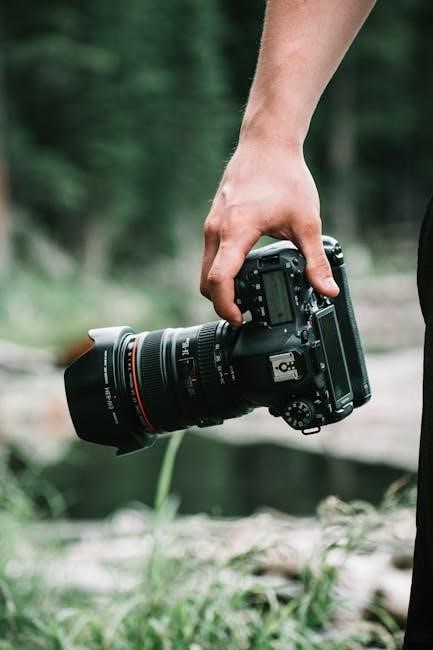
Image Quality and File Formats
This section explains the camera’s image quality settings and file formats‚ including JPEG and RAW options‚ to help photographers choose the best format for their needs.
9.1 JPEG vs. RAW: Pros and Cons
The Nikon D80 offers two primary file formats: JPEG and RAW. JPEG files are compressed‚ smaller in size‚ and ready for immediate use‚ making them ideal for beginners or sharing. However‚ compression reduces image data‚ limiting post-processing flexibility. RAW files‚ in contrast‚ retain all image data‚ providing superior quality and editing capabilities but require larger storage and post-processing time. Understanding these differences helps photographers choose the best format for their workflow and creative goals.
9.2 File Formats and Compression
The Nikon D80 supports various file formats‚ including JPEG‚ RAW‚ and TIFF. JPEG offers three compression levels: Fine‚ Normal‚ and Basic‚ balancing quality and file size. RAW captures uncompressed data for maximum detail‚ while TIFF provides high-quality images without compression. Understanding these formats and compression options allows photographers to optimize storage and image quality‚ ensuring the best results for their specific needs and workflows. Proper use of these settings enhances both efficiency and creativity in photography.
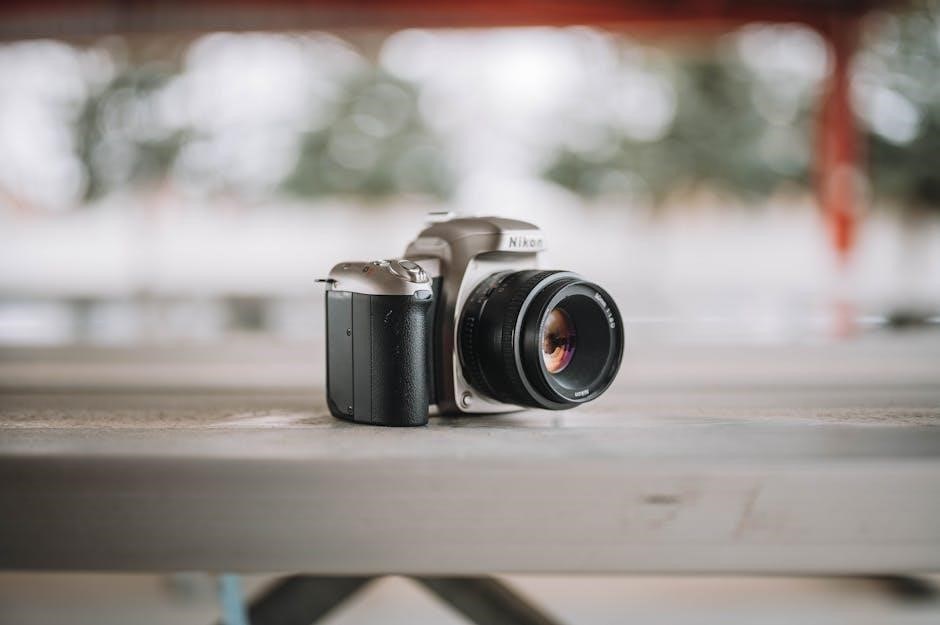
Storage and Memory Management
The Nikon D80 supports JPEG‚ RAW‚ and TIFF formats. JPEG offers three compression levels: Fine‚ Normal‚ and Basic‚ balancing quality and file size. RAW captures uncompressed data‚ while TIFF provides high-quality images without compression. Understanding these formats and compression options allows photographers to optimize storage and image quality‚ ensuring the best results for their specific needs and workflows. Proper use of these settings enhances both efficiency and creativity in photography.
10.1 Compatible Memory Cards
The Nikon D80 supports SD‚ SDHC‚ and SDXC memory cards‚ ensuring flexible storage options. For optimal performance‚ use Class 6 or higher cards. Avoid slower cards‚ as they may cause delays. Always format cards in the camera for compatibility. Using high-speed cards enhances data transfer and shooting efficiency‚ ensuring a smooth photography experience. Proper card management is essential for maintaining image quality and workflow efficiency with the Nikon D80.
10.2 Managing Storage Efficiently
Efficient storage management on the Nikon D80 involves regularly reviewing and deleting unnecessary images; Use the camera’s built-in playback options to organize photos and free up space. Formatting memory cards in the camera ensures optimal performance. Consider using multiple cards to separate different shoots or file types. Always back up images to an external device to prevent data loss. Proper storage management enhances workflow and ensures the Nikon D80 operates at its best.
Playback and Editing Options
The Nikon D80 allows for easy image review on its high-resolution LCD screen. Basic editing features include zoom‚ delete‚ and protect functions‚ enabling quick adjustments and organization of photos during playback.
11.1 Reviewing Images on the LCD
The Nikon D80’s high-resolution 2.5-inch LCD screen allows you to review captured images in detail. Use the multi-selector to navigate through photos and the zoom button to enlarge images for focus verification. Press the INFO button to toggle between basic and detailed shooting data‚ including histograms. Adjust the LCD brightness via the menu for optimal visibility. Protected images are marked with a key icon‚ and unwanted photos can be deleted using the DELETE button‚ with a confirmation prompt to prevent accidental deletion.
11.2 Basic In-Camera Editing Features
The Nikon D80 offers basic in-camera editing tools‚ allowing you to enhance photos without a computer. Use the Trim option to crop images directly on the LCD. Adjust exposure compensation to brighten or darken photos. Convert images to black and white using the monochrome option. These edits can be applied to copied versions of your photos‚ preserving the original files. Access these features through the Retouch menu‚ enabling quick adjustments and previewing changes before saving.
Accessories and Compatibility
The Nikon D80 supports a range of accessories‚ including compatible Nikkor lenses‚ the MB-D80 battery grip‚ and external Speedlights‚ enhancing versatility and shooting performance for diverse photography needs.
12.1 Lenses and Lens Care
The Nikon D80 is compatible with a wide range of Nikkor lenses‚ including AF-S DX models like the 18-135mm kit lens. Proper lens care is essential for maintaining image quality. Use a soft cloth or bulb blower to clean lenses‚ avoiding harsh chemicals. Store lenses in a dry‚ cool place to prevent fungus. Regularly inspect for dust or scratches and clean as needed. Improper care can damage lenses or the camera‚ so follow guidelines carefully to ensure optimal performance and longevity.
12.2 Other Compatible Accessories
Beyond lenses‚ the Nikon D80 supports various accessories for enhanced functionality. The MB-D80 battery grip extends shooting capacity and improves ergonomics. Compatible Speedlights like the SB-800 and SB-600 offer advanced flash control. Remote shutter releases and GPS units are also supported. Additionally‚ the camera works with Nikon’s Creative Lighting System‚ enabling seamless integration with external flash units for professional lighting setups. These accessories expand the D80’s capabilities‚ making it versatile for diverse photography needs.
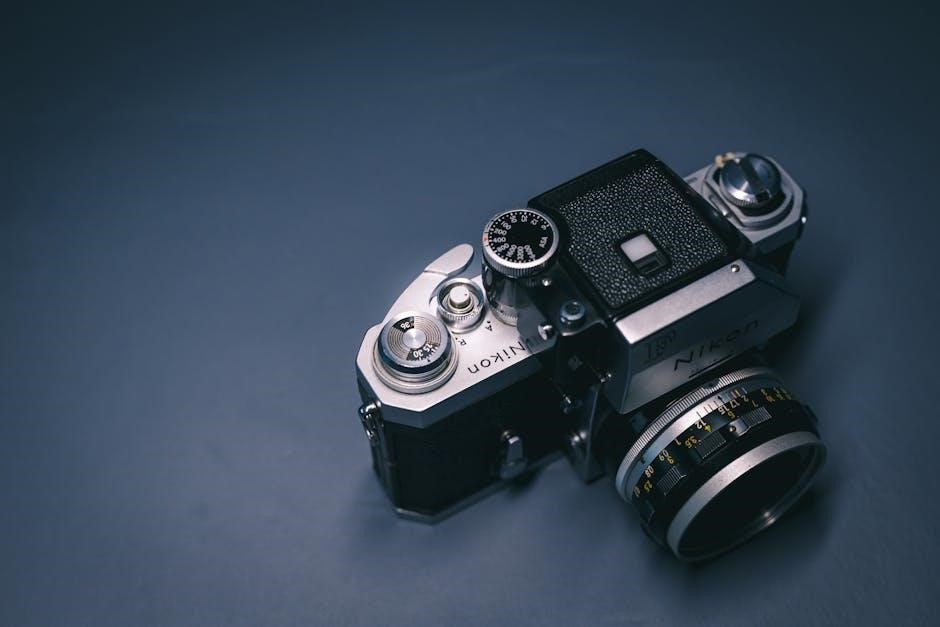
Maintenance and Troubleshooting
Regularly clean the camera and sensor to prevent dust. Check for firmware updates to ensure optimal performance. Address common issues like error messages or connectivity problems promptly for smooth operation.
13.1 Cleaning the Camera and Sensor
Regular cleaning is essential for maintaining image quality. Use a soft brush or bulb blower to remove dust from the lens mount and sensor area. Avoid liquid cleaners to prevent damage. For stubborn spots‚ consult the manual or use professional cleaning services. Always power off the camera before cleaning and avoid touching internal components to minimize risk of damage or malfunction.
13.2 Common Issues and Solutions
Common issues with the Nikon D80 include error messages‚ sensor dust‚ and autofocus malfunctions. For error messages‚ restart the camera or update firmware. Sensor dust can be removed using a blower or professional cleaning. Autofocus issues may require recalibrating lenses or resetting settings. Consult the manual for specific troubleshooting steps or contact Nikon support for assistance. Regular maintenance and updates help prevent these issues and ensure optimal performance.

Firmware Updates
Firmware updates improve camera performance‚ fix bugs‚ and enhance security. Access updates via Nikon’s website or the Manual Viewer 2 app for optimal functionality.
14.1 Importance of Firmware Updates
Firmware updates are essential for enhancing the Nikon D80’s performance‚ fixing bugs‚ and improving security. They ensure optimal functionality‚ compatibility‚ and image quality. Regular updates add new features and resolve issues‚ keeping your camera up-to-date with the latest technology. Always download updates from Nikon’s official website or use the Manual Viewer 2 app to maintain camera efficiency and reliability.
14.2 Updating Firmware: A Step-by-Step Guide
To update the Nikon D80 firmware‚ ensure the camera is fully charged and connected to a computer. Download the latest firmware from Nikon’s official website or via the Manual Viewer 2 app. Extract the downloaded file and transfer it to the memory card. Insert the card into the camera‚ navigate to the firmware update option in the menu‚ and follow on-screen instructions to complete the update. This process ensures improved functionality and performance.
Mastery of the Nikon D80’s features and techniques empowers photographers to unlock its full potential‚ ensuring exceptional image quality and versatility in various shooting scenarios.
15.1 Summary of Key Features
The Nikon D80 offers a 10.2-megapixel CMOS sensor‚ 11-point autofocus‚ and ISO 100-1600 sensitivity. It features a 2.5-inch LCD‚ RAW image support‚ and compatibility with Nikon’s Creative Lighting System. The camera supports various shooting modes‚ including Auto‚ Program‚ Aperture Priority‚ Shutter Priority‚ and Manual. It also includes built-in flash‚ customizable menu options‚ and a robust build quality‚ making it versatile for both beginners and advanced photographers.
15.2 Encouragement to Practice
Practicing with your Nikon D80 is essential to mastering its features and enhancing your photography skills. Experiment with different shooting modes‚ explore manual controls‚ and test various lighting conditions. Regular practice helps you understand exposure‚ composition‚ and focus techniques. Capture diverse subjects to refine your style and creativity. The more you use the camera‚ the more intuitive it becomes. Keep experimenting and reviewing your results to continuously improve your craft and unlock the full potential of your Nikon D80.

